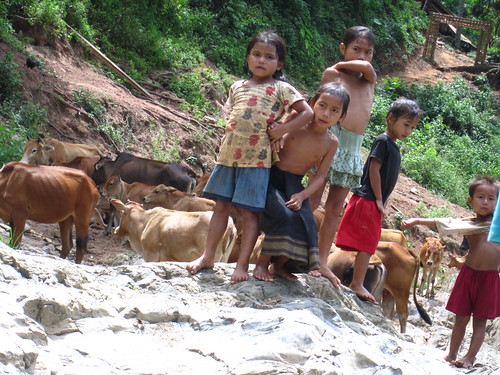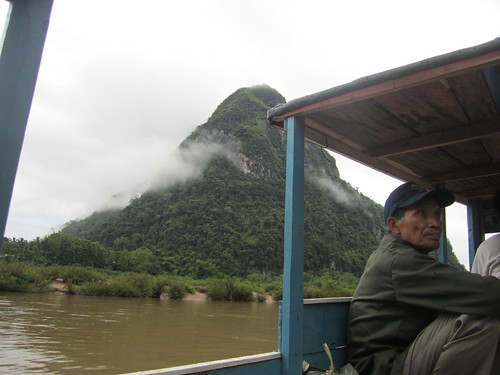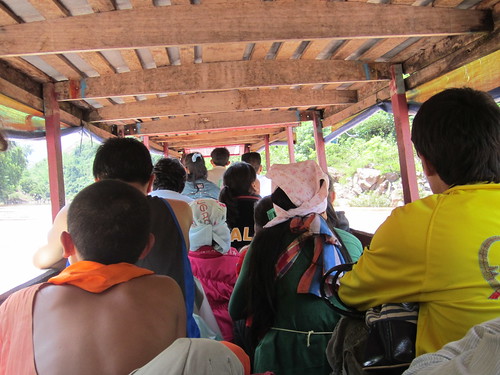By Stephen Bugno
Before visiting Laos I had images of gliding down rivers at an impossibly slow speed all the while enjoying both the view and necessary transportation with friendly locals.

That was hardly the case. In fact, it describes only one of my four slow boat rides. The reality is, the slow boat is being replaced by bus and songthaew as a means of transportation, especially now that roads are improving slightly. The only genuine slow boats that are still plying the rivers of Laos are the ones where no roads go. So that’s the secret to getting a real slow boat experience: choose your routes wisely.
Below is a description of a few of the slow boat routes on the waterways of the Nam Ou and the Mekong in northern Laos
Houayxai to Pakbeng
This is the most touristy slow boat experience. Groups of backpackers are shuttled from Chiang Mai, Thailand to the border with Laos and are packed on to huge boats for the two-day journey to Luang Prabang, stopping at the village of Pakbeng for the night. Eating, drinking, music, card playing were all commonplace on the boat I rode. Out of about 150 passengers, only two were Laotians. Needless to say, this was not a Lao cultural experience. It was, however, riding a slow boat down the Mekong.
The boat is a huge one, and the scenery is pleasant, passing villages and quite remote areas of the country. It leaves more or less at 11am from the slow boat docks 1km upstream from Houayxai. This trip is a mainstay on the Banana Pancake trail.
Scenery: Very Nice Touristy: Very Touristy Time: 5-6 hours Costs: 110,000-130,000 kip
Hat Sa to Muang Khoua
This is the most remote and off the beaten track slow boat that I rode, and consequently the most authentic. The boat was so narrow that it only allowed two people to sit abreast. The bags were loaded into the back of the boat and covered by a tarp. The boat was filled with all locals except for my chain-smoking Swiss friend who shared his cigarettes with our new friends as well some rambutan and bananas we bought before boarding. We passed remote bamboo villages, the inhabitants farming the hillsides with subsistence agriculture.
About every thirty minutes of the we passed a village on the riverbank, usually comprised of less than 25 houses. Most times there would be a fisherman casing a net or kids playing in the river alongside their water buffalos.
Hat Sa is only a village, but serves as the Phongsali’s river port, reachable by bus via a slow-going 24 km winding dirt road.
Scenery: Nice, but not spectacular Touristy: Very local Time: 4-5 hours Cost: 100,000 kip
Muang Khoua to Muang Ngoi
You’ll arrive in Muang Khoua in the afternoon and most likely spend the night there. From the wooden balcony of my guesthouse’s restaurant, I watched life unfold in and around the river. There is no bridge on this road that passes through the village going to the Vietnamese border. A tug-boat of sorts nudges a ferry barge the short push across whenever traffic arrives. Local long boats come and go. A neighbor buns rubbish. Kids play and swim in the water on both sides of the river.
I met a teacher and freelance trekking guide who was strategically hanging out close by. We got to talking, and unfortunately I didn’t have the time or extra money to go on one of his three day treks to nearby hill tribe villages. So we’d have to hang around the rest of the afternoon and be out on the boat at nine the next morning. “Do you have internet in town?” I asked. “No,” he laughed. “We just got electricity.”
The 4-5 hour trip to Muang Ngoi leaves in the morning, usually around 9am and because there are very few locals making this trip, filling up a boat depends on how many travels are present. You’ll need at least 6-8 passengers to make the fare (approx 1 million kip per boat) more reasonable for each passenger.
The scenery gets more and more outstanding, with dramatic karsts, as you get closer to Muang Ngoi.
Scenery: Very Nice Touristy: Mostly tourists, but small boat Time: 4-5 hours Cost: 100,000-120,000
Muang Ngoi to Nong Khiaw
Muang Ngoi is a quiet little traffic-free village. It feels very cut off from the rest of the world. My travel partner stayed here for three days as I made my way more slowly down the Nam Ou. Most of the time he spent in his hammock and at the local cafes reading, writing in his journal and soaking up the gorgeous views of the surrounding limestone mountains. If I had the chance, I would return to Muang Ngoi for some serious chill time.
The following morning we got the 9:30 am boat to Nong Khiaw. This is one of the most scenic slow boat rides in all of Laos. And one of the most packed little boats I had ever been on: both with locals and their cargo and backpackers moving on downstream. It’s hard to tire of these serene mountains that have an ancient and oriental air to them.
Scenery: Very Nice Touristy: Locals and travelers Time: 1 hour Cost: 20,000 kip
Nong Khiaw to Luang Prabang
Slow-boating it from Nong Khiaw to Luang Prabang is also supposed to be a trip of spectacular beauty. But I opted for the 40,000 kip ride in the back of a sawngtheaw to save a bundle of money. In general, taking ground transportation saves money over river transport.
The boat to Luang Prabang supposedly leaves at 11am, and if I had to guess, I’d say very few locals would be taking it, seeing that the bus is so much cheaper. But if I had the money, I’d opt for this scenic route on the river.
Scenery: Nice Touristy: Touristy Time: 5 hours Cost: ?




